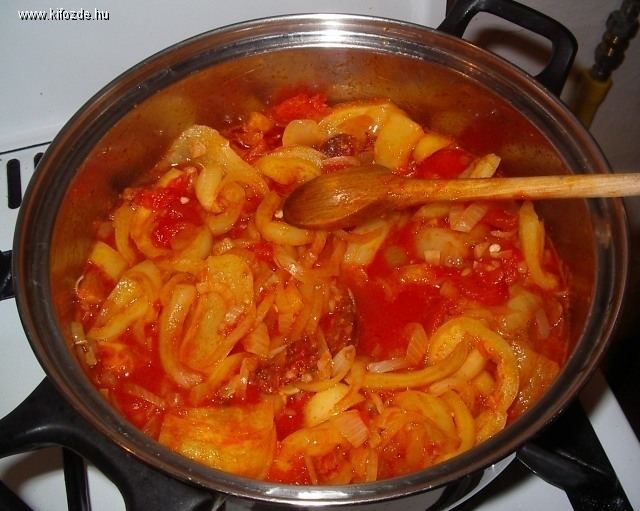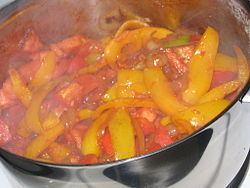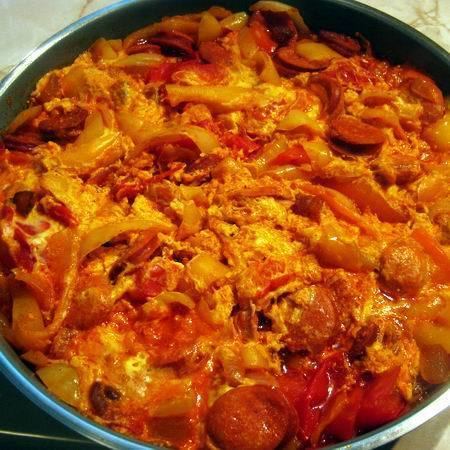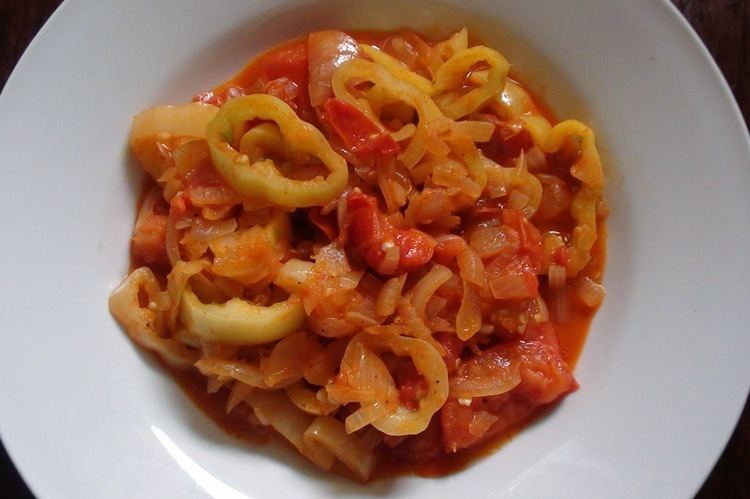 | ||
Similar Solyanka, Goulash, Ajika, Pörkölt, Zucchini | ||
Lecsó (English Lecho, [ˈlɛʧoː] "LETCH-oh"; Hungarian: lecsó [ˈlɛʧoː], Czech and Slovak lečo, German: Letscho, Polish: leczo, Russian: лечо) is a Hungarian thick vegetable ragout or stew which features explicitly yellow pointed peppers, tomato, onion, salt, and ground sweet and/or hot paprika as a base recipe. The onions and peppers are usually sauteed in lard, bacon fat or sunflower oil. Garlic can also be a traditional ingredient. It is also considered to be traditional food in Czech, Slovak and Croatian cuisine and is also very common in Poland, Austria, and Israel.
Contents

Most Hungarian recipes recommend the mildest variant of Hungarian wax pepper, which are in season August–October which is also when field tomatoes are at their best. Other recipes suggest using both bell pepper and banana pepper as alternatives.

Hungry hungarian mealtime lethal lecs
Varieties

There is a large variety of lecsós, the base of all being a mixture of tomatoes and peppers (both sweet and hot), onions, spiced with salt, some variants also sugar, a fair amount of red paprika powder and often garlic. Some recipes may also use bay leaf, ground black pepper or thyme. To make the perfect lecsó base, one must render the lard from the smoked bacon (if that is used instead of oil, which is also common), and fry the onion slices until the edges become slightly brownish. Next the pepper slices must be added and fried until crisp. The tomatoes come last because, if added at the beginning, they would soak the onions and the peppers.

Lecsó may be made with potatoes, cooked rice or egg barley (called tarhonya). Another accompaniment which is quite common is nokedli (similar to spaetzle). It is possible to make lecsó with green tomatoes, cold lecsó in aspic, and to serve the warm dish with sour cream or in a pancake, as a filling. Some recipes are with meat, sausage[6] (called "kolbász" such as lecsókolbász, made specifically for this purpose, or Debrecener sausage) bacon or smoked pork chops, liver and sliced hot dog sausages. Some are decorated with slices of hard-boiled egg or thickened with beaten eggs. Even cabbage and pumpkin may be added at times. If meat is added, it may be added first, and fried with the onions and pepper slices.

Lecsó, like its French semi-counterpart ratatouille, often stands alone as a lunch dish, in which case it is often consumed with bread. Plain lecsó can be served as a side dish accompanying various main dishes, for example roasted chicken, pheasant, pork, beef or Eszterhazy steak. It is widely known in Hungary that the best lecsó is made over an open fire in a "bogrács" (a cauldron), a Hungarian style barbecue. In Hungary the dish is very popular, and even has its own festivals.

In Germany, lecsó is referred to as Letscho and often used as the primary ingredient of a sauce that is used with many different meals. It is usually made of tomatoes, peppers, and onions among other regional additions.
In Poland, lecsó (called leczo) is usually made from red pepper, zucchini, tomatoes, onion and garlic, sausage, and spiced with powdered chilli pepper. Leczo should be served hot and spicy. It probably came to Poland from Hungary.
